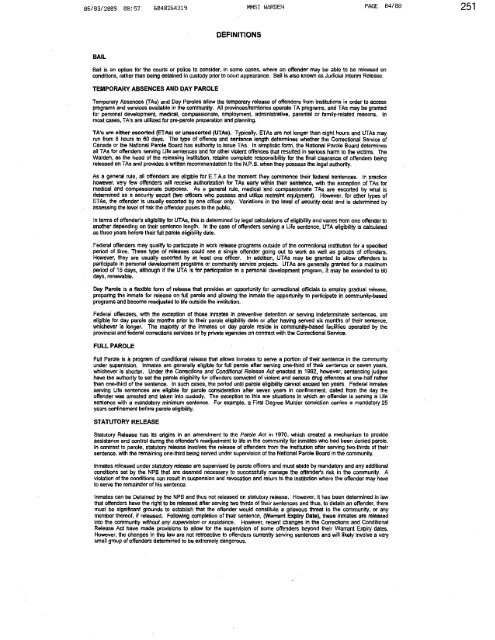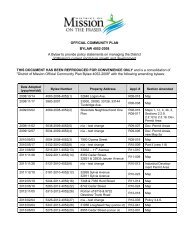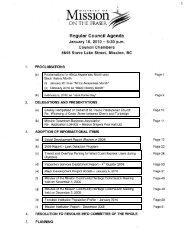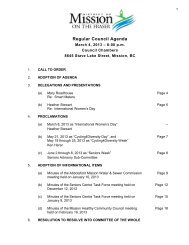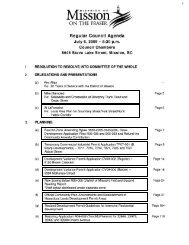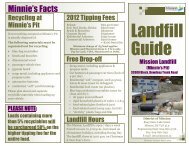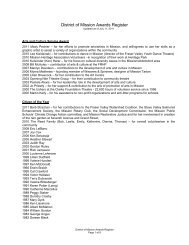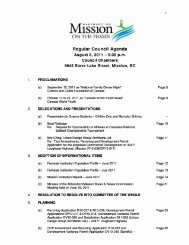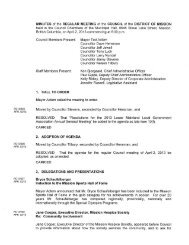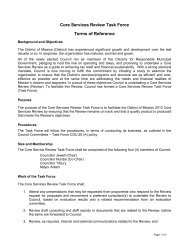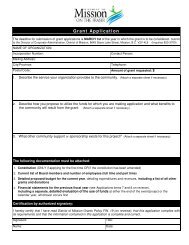June 15, 2009 - District of Mission
June 15, 2009 - District of Mission
June 15, 2009 - District of Mission
Create successful ePaper yourself
Turn your PDF publications into a flip-book with our unique Google optimized e-Paper software.
06/03/<strong>2009</strong> 08:52 6048264319 MMSI WARDEN PAGE 04/08 251<br />
DEFINITIONS<br />
BAIL<br />
Bail is an option for the courts or police to consider, in some cases, where an <strong>of</strong>fender may be able to be released on<br />
conditions, rather than being detained in custody prior to court appearance. Bail is also known as Judicial Interim Release.<br />
TEMPORARY . ABSENCES AND DAY PAROLE<br />
Temporary Absences (TAs) and Day Paroles allow the temporary release <strong>of</strong> <strong>of</strong>fenders from institutions in order to access<br />
programs and services available in the community. All provincesfterritories operate TA programs, and TAs may be granted<br />
for personal development, medical, compassionate, employment, administrative, parental or family-related reasons, In<br />
most cases, TA's are utilized for pre-parole preparation and planning.<br />
TA's are either escorted (ETAs) or unescorted (UTAs). Typically, ETAs are not longer than eight hours and UTAs may<br />
run from 8 hours to 60 days. The type <strong>of</strong> <strong>of</strong>fence and sentence length determines whether the Correctional Service <strong>of</strong><br />
Canada or the National Parole Board has authority to issue TAs. In simplistic form, the National Parole Board determines<br />
all TAs for <strong>of</strong>fenders serving Life sentences and for other violent <strong>of</strong>fences that resulted in serious harm to the victims. The<br />
Warden, as the head <strong>of</strong> the releasing institution, retains complete responsibility for the final clearance <strong>of</strong> <strong>of</strong>fenders being<br />
released on TAs and provides a written recommendation to the N.P.B. when they possess the legal authority.<br />
As a general rule, all <strong>of</strong>fenders are eligible for E.T.A.s the moment they commence their federal sentences. In practice<br />
however, very few <strong>of</strong>fenders will receive authorization for TAs early within their sentence, with the exception <strong>of</strong> TAs for<br />
medical and compassionate purposes. As a general rule, medical and compassionate TAs are escorted by what is<br />
determined as a security escort (two <strong>of</strong>ficers who possess and utilize restraint equipment). However, for other types <strong>of</strong><br />
ETAs, the <strong>of</strong>fender is usually escorted by one <strong>of</strong>ficer only. Variations in the level <strong>of</strong> security exist and is determined by<br />
assessing the level <strong>of</strong> risk the <strong>of</strong>fender poses to the public.<br />
In terms <strong>of</strong> <strong>of</strong>fender's eligibility for UTAs, this is determined by legal calculations <strong>of</strong> eligibility and vanes from one <strong>of</strong>fender to<br />
another depending on their sentence length. In the case <strong>of</strong> <strong>of</strong>fenders serving a Life sentence, UTA eligibility is calculated<br />
as three years before their full parole eligibility date.<br />
Federal <strong>of</strong>fenders may qualify to participate in work release programs outside <strong>of</strong> the correctional institution for a specified<br />
period <strong>of</strong> time. These type <strong>of</strong> releases could see a single <strong>of</strong>fender going out to work as well as groups <strong>of</strong> <strong>of</strong>fenders,<br />
However, they are usually escorted by at least one <strong>of</strong>ficer. In addition, UTAs may be granted to allow <strong>of</strong>fenders to<br />
participate in personal development programs or community service projects. UTAs are generally granted for a maximum<br />
period <strong>of</strong> <strong>15</strong> days, although if the UTA is for participation in a personal development program, it may be extended to 60<br />
days, renewable.<br />
Day Parole is a flexible form <strong>of</strong> release that provides an opportunity for correctional <strong>of</strong>ficials to employ gradual release,<br />
preparing the inmate for release on full parole and allowing the inmate the opportunity to participate in community-based<br />
programs and become readjusted to life outside the institution,<br />
Federal <strong>of</strong>fenders, with the exception <strong>of</strong> those inmates in preventive detention or serving indeterminate sentences, are<br />
eligible for day parole six months prior to their parole eligibility date or after having served six months <strong>of</strong> their sentence,<br />
whichever is longer. The majority <strong>of</strong> the inmates on day parole reside in community-based facilities operated by the<br />
provincial and federal corrections services or by private agencies on contract with the Correctional Service,<br />
FULL PAROLE<br />
Full Parole is a program <strong>of</strong> conditional release that allows inmates to serve a portion <strong>of</strong> their sentence in the community<br />
under supervision. Inmates are generally eligible for full parole after serving one-third <strong>of</strong> their sentence or seven years,<br />
whichever is shorter. Under the Corrections and Conditional Release Act enacted in 1992, however, sentencing judges<br />
have the authority to set the parole eligibility for <strong>of</strong>fenders convicted <strong>of</strong> violent and serious drug <strong>of</strong>fences at one-half rather<br />
than one-third <strong>of</strong> the sentence, In such cases, the period until parole eligibility cannot exceed ten years. Federal inmates<br />
serving Life sentences are eligible for parole consideration after seven years in confinement, dated from the day the<br />
<strong>of</strong>fender was arrested and taken into custody. The exception to this are situations in which an <strong>of</strong>fender is serving a Life<br />
sentence with a mandatory minimum sentence. For example, a First Degree Murder conviction carries a mandatory 25<br />
years confinement before parole eligibility.<br />
STATUTORY RELEASE<br />
Statutory Release has its origins in an amendment to the Parole Act in 1970. which created a mechanism to provide<br />
assistance and control during the <strong>of</strong>fender's readjustment to life in the community for inmates who had been denied parole,<br />
In contrast to parole, statutory release involves the release <strong>of</strong> <strong>of</strong>fenders from the institution after serving two-thirds <strong>of</strong> their<br />
sentence, with the remaining one-third being served under supervision <strong>of</strong> the National Parole Board in the community.<br />
Inmates released under statutory release are supervised by parole <strong>of</strong>ficers and must abide by mandatory and any additional<br />
conditions set by the NPB that are deemed necessary to successfully manage the <strong>of</strong>fenders risk in the community. A<br />
violation <strong>of</strong> the conditions can result in suspension and revocation and return to the institution where the <strong>of</strong>fender may have<br />
to serve the remainder <strong>of</strong> his sentence.<br />
Inmates can be Detained by the NPB and thus not released on statutory release. However, it has been determined in law<br />
that <strong>of</strong>fenders have the right to be released after serving two thirds <strong>of</strong> their sentences and thus, to detain an <strong>of</strong>fender, there<br />
must be significant grounds to establish that the <strong>of</strong>fender would constitute a grievous threat to the community, or any<br />
member there<strong>of</strong>, if released. Following completion <strong>of</strong> their sentence, (Warrant Expiry Date), these inmates are released<br />
into the community without any supervision or assistance. However, recent changes in the Corrections and Conditional<br />
Release Act have made provisions to allow for the supervision <strong>of</strong> some <strong>of</strong>fenders beyond their Warrant Expiry dates.<br />
However, the changes in this law are not retroactive to <strong>of</strong>fenders currently serving sentences and will likely involve a very<br />
small group <strong>of</strong> <strong>of</strong>fenders determined to be extremely dangerous,


